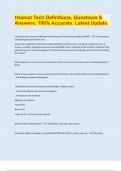Exam (elaborations)
Hazmat Tech Definitions, Questions & Answers. 100% Accurate. Latest Update.
- Course
- Hazmat Tech
- Institution
- Hazmat Tech
Hazmat Tech Definitions, Questions & Answers. 100% Accurate. Latest Update. Technician level personnel defined IAW the National Fire Protection Agency (NFPA) - -The hazardous materials technician shall be that person who responds to hazardous materials/WMD incidents using a risk-based respons...
[Show more]



